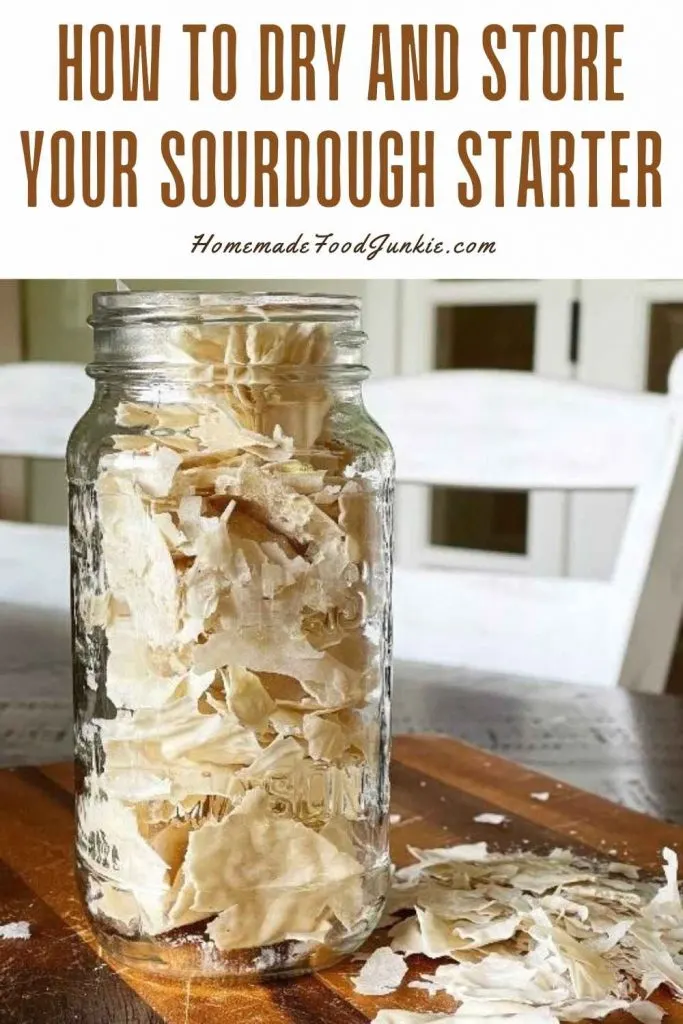Sourdough starter is simple to dry and preserve for long term storage. Dry Sourdough starter is safe to store at room temperatures indefinitely if it is properly dried. You can rehydrate dried sourdough and bake with it in roughly five to seven days.
How do your dry sourdough starter? You can dry sourdough starter by spreading active sourdough starter on parchment and leaving it out to air dry, drying it (carefully) in your oven, or drying sourdough starter it your food dehydrator.
We give you all the details on these methods in this post and we show you how to rehydrate a dried starter so you can use it again.
Why Dry Sourdough Starter? Keeping a supply of dried sourdough starter in the pantry or freezer ensures you have a way to revive your starter in half the time of starting one from scratch.
If disaster strikes and you lose your working starter to bad bacteria, mold or neglect, your dried starter will back you up.
You can also share dried sourdough starter with family and friends, or sell it. It is so interesting to experiment with the diverse flavors sourdough starters offer.
Did you know there is a Sourdough Starter library in Belgium? They collect, store and sell MANY unique heritage old world starters. Think of the possibilities!
How Long Can You Keep a Sourdough Starter? A well maintained sourdough starter can last hundreds of years. Some sourdough starters are passed down through families for generations. Drying your precious heirloom starter is a good way to protect it.
By drying and preserving your starter, you are ensuring you can pass it down to your friends and family. Start a sourdough tradition in your family.
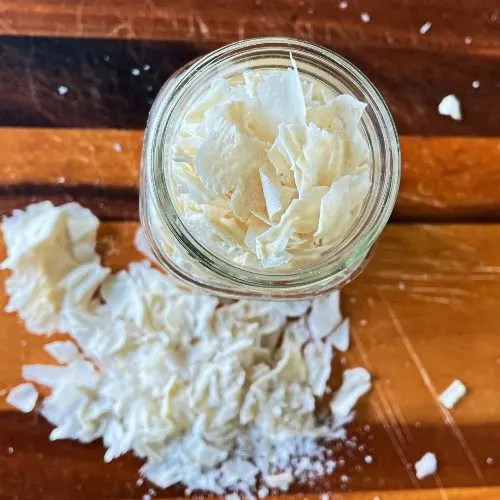
Can I mail sourdough starter? Once you dry a starter properly you can crush it into powder and mail it anywhere in the world. We recommend you place dried starter in small ziplock bags that will fit easily into an envelope with a slip of paper. Include reactivation instructions for the recipient.
How to Dry Sourdough Starter:
As you go through the process of making your own sourdough starter from scratch you learn it grows from a process of Fermentation of flour and water along with local wild yeasts and lactic acid bacteria. The populations of bacteria and yeast are specific to your local area.
The yeasts and bacteria are living, metabolizing, beings that need regular feeding to maintain a strong starter. When you want to take a break from baking or go on an extended vacation, starters tend to be pushed to the back of the fridge and forgotten. This makes them weak and susceptible to molds and bad bacteria.
It’s better to have supply of dried starter on hand to easily replace an old corrupted starter. Reconstituted starters are usually ready to bake in less than a week. Sometimes even sooner.
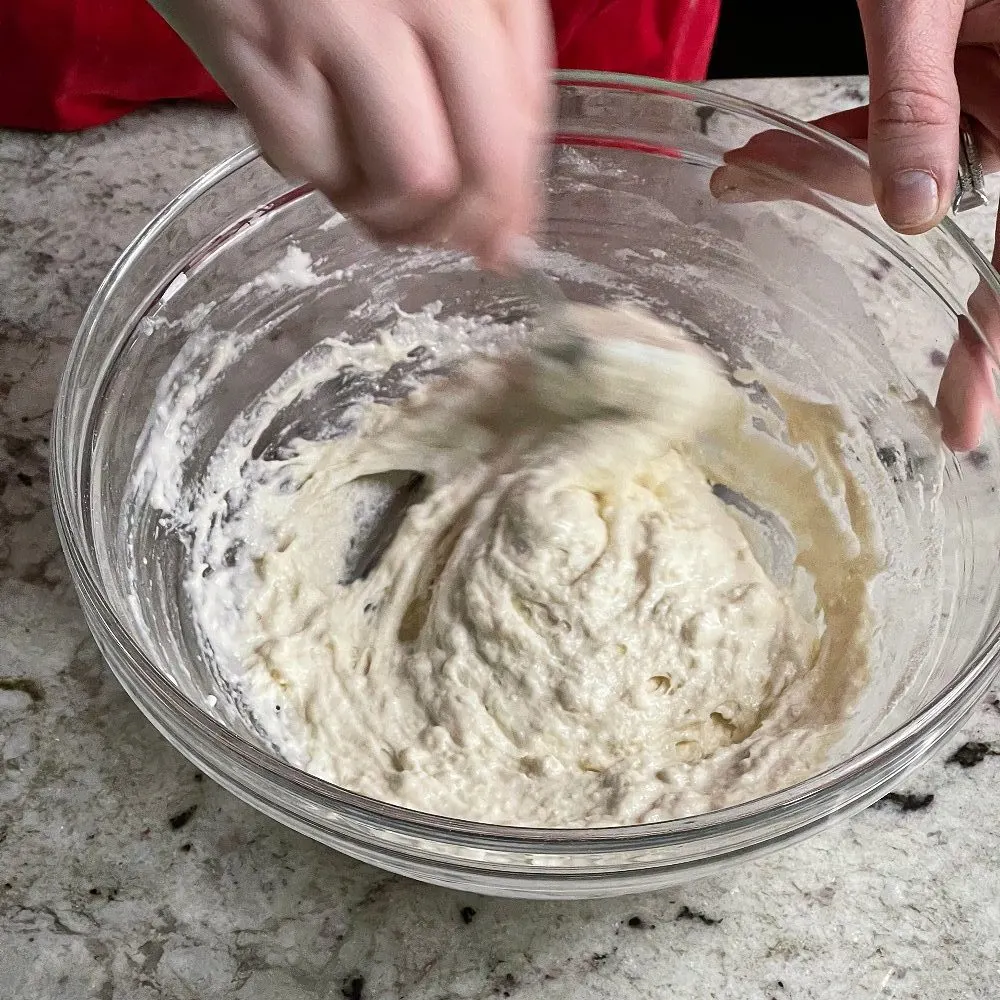
Prepping the Starter for Drying:
Do you feed your sourdough starter before drying? For best results you should feed your starter before drying it. You want to dry a strong, balanced for baking, fed starter.
Having a well fed active starter to dry ensures the process of reviving your dried starter is reliable and quick.
An active mature sourdough starter is best for drying. Young starters lack the power needed for a quick and strong rehydration. If you have a young starter that is barely rising bread, keep feeding it until it is rising bread well, doubling in size and has a good structure of bubbles
- You need to Feed your starter, as if you were going to bake with it, to prepare it for drying.
- In a quart size bowl, Combine 100 grams room temperature starter with 100 grams flour and 100 grams warm water.
- Stir it all together until you have a thick smooth paste with no flour lumps.
- Now let the starter sit until it grows and bubbles up to about double in size. Once your starter is all bubbly it will have a strong structure, perfect for drying and later rehydrating.
- 300 grams of fed starter will yield about 3/4 Cups of crushed and powdered starter to store.
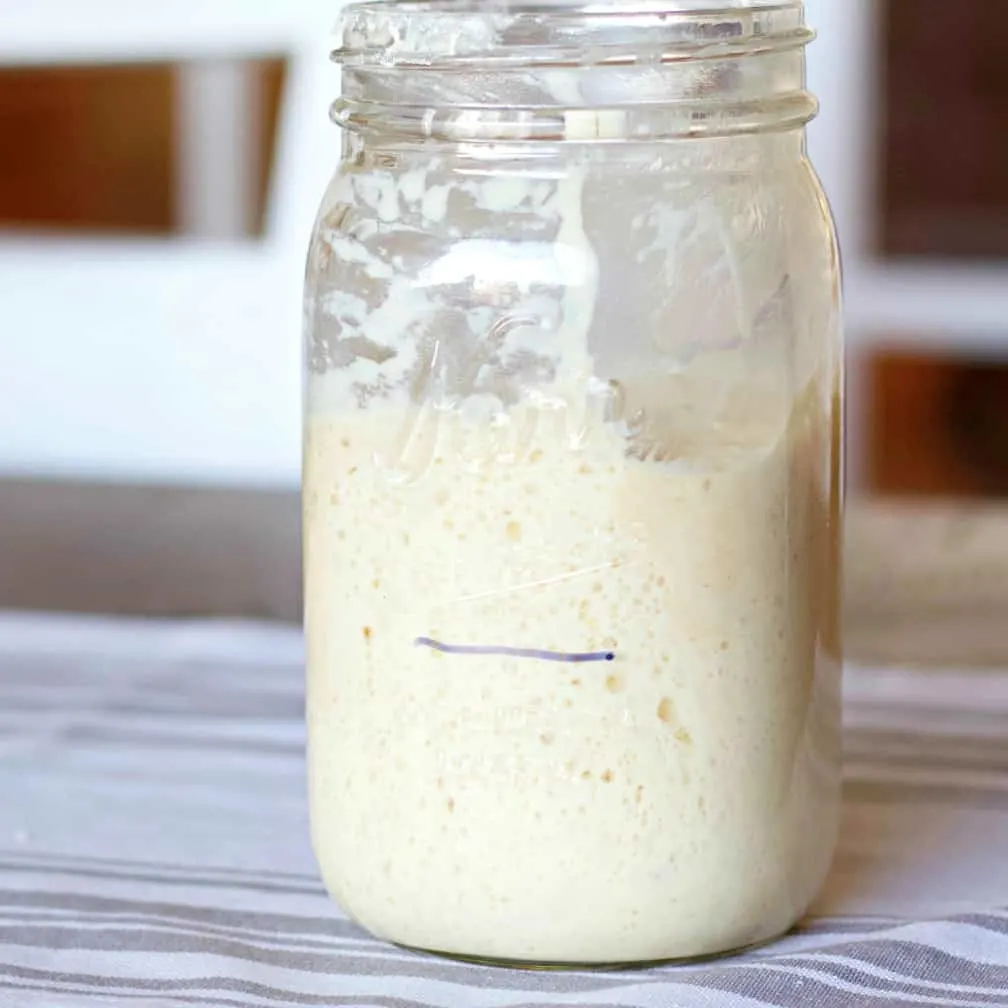
Can You Dry Sourdough Discard?
After you feed your wet sourdough starter for baking it will double in size. You can dry the extra fully fed and active sourdough discard not needed for the bread recipe.
How do you Dry Out Sourdough Starter? The Methods:
How do you dry sourdough starter for long term storage? The three methods used for drying sourdough starter are oven drying, air drying and drying it in a food dehydrator.
I used all of my fed and balanced starter to dry. I had two trays of starter to dry. I used one parchment and one silpat on each tray to see how they went through the process using the same methods.
Whatever method you choose remember, For best long term storage the starter needs to be COMPLETELY dried out. It should give a nice sharp snap when you break it.
TIPS For all drying methods:
- A baking sheet will give you strength and contain the starter so it is easy to move around. You can omit a baking sheet if you use the air drying method but a baking sheet is preferred for stability.
- Spread the starter out in a very thin sheet on either parchment paper or a silicone baking mat. Silicone mats are easiest to work with. Here are my favorite silicone baking sheets from Amazon.
- An offset spatula, like these From Amazon, does a great job of spreading starter evenly.
- If using a food dehydrator, you will need a fruit leather sheet or silicone mat that fits the tray or line the tray with parchment.
I used both parchment and silicone mats so you can see how they work. In my opinion, it is easier to spread the starter on a silicone mat. But in the end both silicone and parchment work just fine.
Air Drying Sourdough Starter:
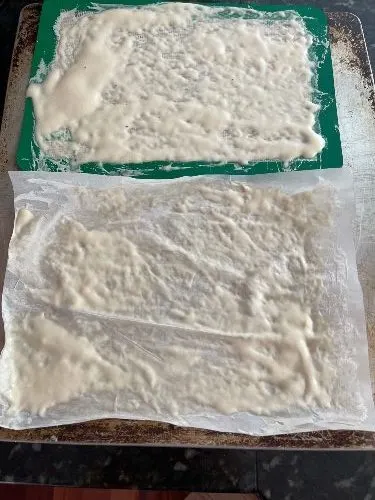
This is the easiest, no fuss method of drying starter if your kitchen is warm and dry it takes about 12 to 24 hours to complete. To reduce the drying time set a fan nearby or open a window if the air outside is warm and dry. Constant Air flow will definitely dry your starter faster than stagnant air.
- Line a baking sheet with a silicone mat or a piece of parchment paper
- Spread your prepared active sourdough starter on the baking sheet very thinly.
- Set the baking sheet in a well ventilated warm area of your kitchen.
- Allow the starter to completely dry out.
- Remove the dried starter and store in an airtight container.
One more thing about air drying starter. Wet starter WILL attract fruit flies and other small critters. You will see them landing all over your exposed wet starter if you leave it out with no cover. This can be problematic.
I recommend using a clean window screen over the top of the tray if you have one that fits to avoid getting bugs in your dried starter. It will have to cover the starter with no gaps or the bugs will get to the starter. Not a nice thing.
Can I Dehydrate my Sourdough Starter in the Oven?
You can dry sourdough starter in your oven with these precautions. The temperature has to stay very low so you don’t kill the bacteria and yeasts in your starter. The bread proofing function will work well for most people.
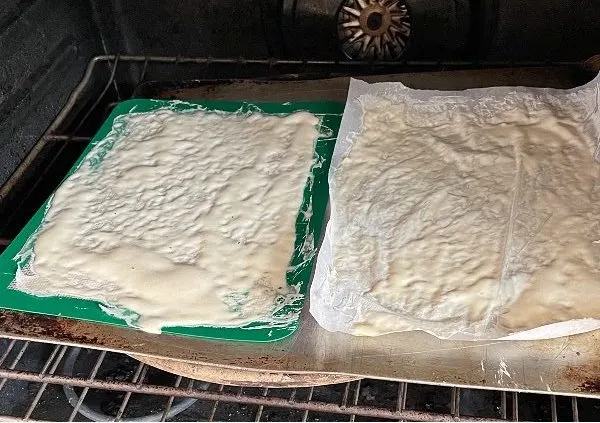
If you have a convection oven, set it to the lowest heat setting. (for my oven that is 100 degrees F.). I also have a drying function on my oven but it won’t go under 140 degrees F. so I chose not to use it.
However, I found the fan in my oven did help keep the heat from becoming too intense on the starter so higher temps up to 140 Degrees F. might dry the starter with a fan and not kill it.
To dry sourdough starter in the oven:
- Set your parchment paper or silicone mat on the baking sheet
- Spread your active sourdough starter on the baking sheet in a thin sheet.
- Set the baking sheet in the oven and just turn on the oven light. OR use the proofing function on your oven. You want the oven at about 90 degrees F. A convection oven fan will help the process.
- Set the timer for 12 hours.
- remove the starter and break a piece off. It should be very dry and give a good dry break like a chip. If the starter is still mushy or spongy set it back in oven and repeat.
Drying Sourdough Starter in a Food Dehydrator:
You need to be careful not to use too high a temperature or you can kill your starter. Some dehydrators cannot be set low enough. 90 to 95 degrees F. is a safe drying temperature for sourdough starter.
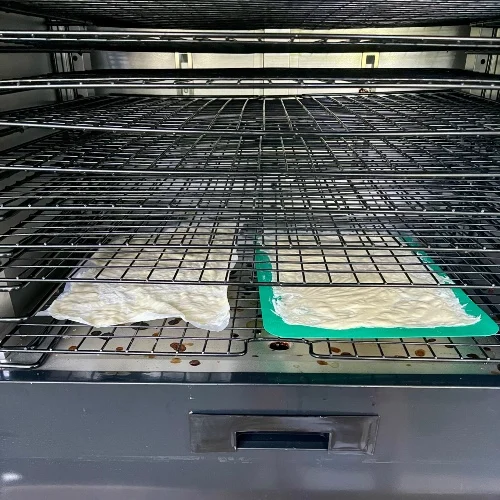
- line your dehydrator trays with a silicone mat, fruit leather tray or parchment. As you can see, the parchment will wrinkle as the starter dries and may be a bit messier.
- Spread the starter on to make a very thin sheet.
- Set the trays into the dehydrator.
- Set the dehydrator to 95 degrees
- Check in 8 hours. If starter snaps when broken it is ready.
- remove and break into small pieces or grind into powder and store in air tight containers.
How Long Does it Take to Dry Sourdough Starter?
Drying sourdough starter takes from one to three days depending on conditions. How long it takes to dry a starter depends on both the temperature and humidity involved in the process.
Air drying is especially difficult to predict drying times since kitchen temperatures, air flow and humidity vary widely. A warm dry air kitchen with lots of air flow will dry thinly spread starter in about 12 to 14 hours.
However, Highly humid places with low temperatures will take much longer. That is my local climate. With good air flow, (or a fan), I can dry a thinly spread starter in 24 to 48 hours. But it may take longer. So I use my oven or food dehydrator.
After the sourdough starter is crispy and dry, break it into pieces or powder it. not it is easy to store in airtight bags or containers.
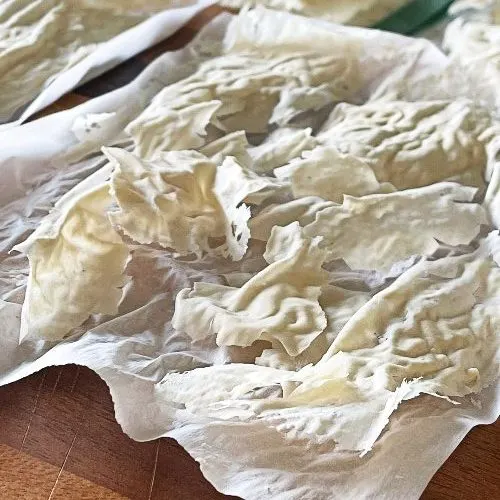
Once your starter is completely dry, brittle and snaps sharply when broken, break it up into pieces.
How to Store Dried Starter:
How long are you going to store it? For short term storage a quick crush to fit into the jar or plastic bag will work. It will store at room temperature quite a while (a year or more).
Notice though the air in the jar and plastic bag. Eventually this will degrade the starter. So think short term storage here.
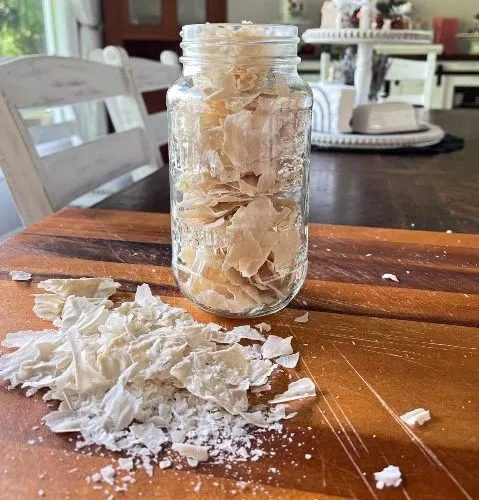
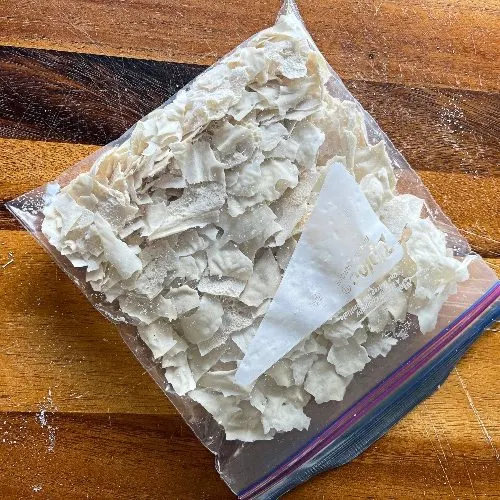
Crushing the starter with a rolling pin will give you a better outcome for storage. It will save you a lot of storage space and remove a lot of the air in the container.
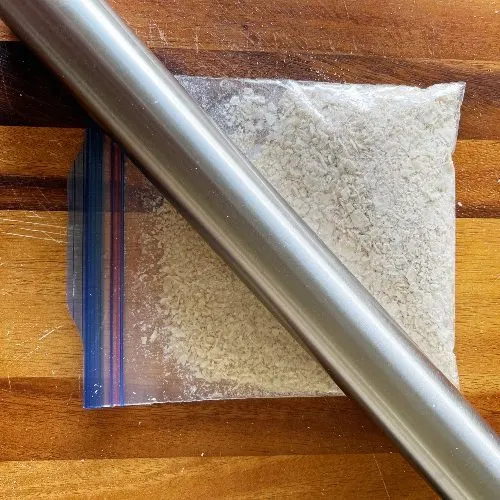
For mailing the starter or long term storage in the freezer, you can break or crush the dried starter and put it through your food processor (or blender?) to get those pieces really small.
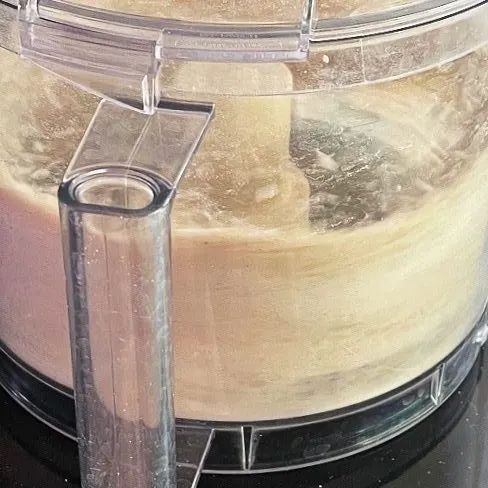
Can you Freeze Dry Sourdough Starter?
Can sourdough starter be frozen? You absolutely can freeze dry sourdough starter. Once the sourdough starter is completely dried you can freeze it in air tight zip lock freezer bags with all the air sucked out.
Once you get your starter dried you can store it at room temperatures. But to make it absolutely the longest preservation with no chance of bad bacteria getting into it, freeze it. Here’s How:
- You want to crumble or powder the dried starter pretty fine for freezing.
- Suck all the air out of the bag. Air causes oxidation. This will cause freezer burn and degrade the starter over time.
- Label the bag clearly with the name of the starter and the current date.
- Double bag the starter if you plan to go for LONG term freezing of several years.
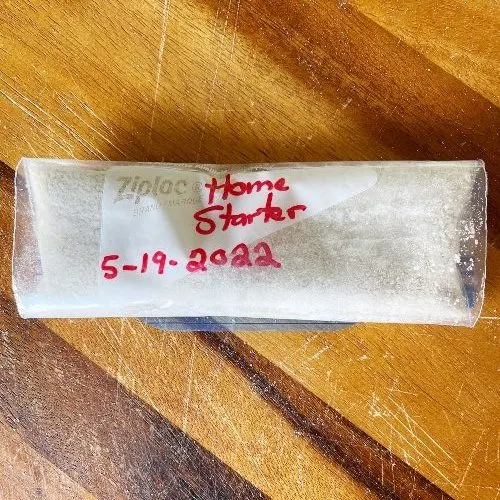
How long Does Freeze Dried Sourdough Starter Last? A starter that is properly dried and frozen can last indefinitely. But put it in a part of the freezer you can find so it doesn’t get lost.
Can you Purchase Dried Sourdough Starters?
If you don’t want to dry your own starter or (or make your own from scratch) purchase one. Purchased starters are all a new experience in various bread flavors you cannot experience otherwise.
When you purchase dehydrated sourdough starters made with different wild yeasts and interesting ingredients your sourdough baking expands, yet again.
Your favorite crusty sourdough bread loaf recipe will transform into something brand new when you use a different starter with a new flavor profile to ferment the dough.
This is true because wild yeast is adapted to the local climate and kitchen it is created in. Your starter can only capture local yeasts. So purchasing (or sharing) with bakers from other locals will bring new flavors to your sourdough breads.
We have purchased and reactivated two dried starters. Sasha Hunter sells her Apple Jack starter in dried form on Facebook Marketplace here. Sasha uses apples in her starter and the results are amazing. Amanda bought it and makes sourdough bread with a subtle apple flavor. Her family LOVES it.
We also purchased Zourdough Sourdough’s Beast starter from their Etsy shop. Again a very interesting result to the flavor and structure of the bread.
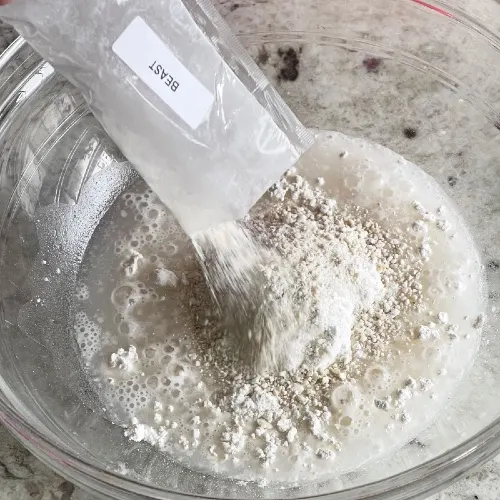
How to Revive A Dried Sourdough Starter:
To revive a dried starter you add back the water and (maybe add flour)and wait. And then add in some more water and flour and wait. The yeast and bacteria will slowly revive and begin metabolizing again. Repeat feedings until your dried starter is fully reconstituted and active again.
NOTE: We add a bit of sugar in the beginning of this process. If you don’t want to add sugar to your starter you can omit it. It’s just there to jump starter the process. Without sugar, the process will still happen but might take a day or so longer.
Can you substitute other sweeteners when reconstituting a dried starter? Yes you can. Honey, agave syrup, even maple syrup can replace the sugar if you prefer them.
We do NOT recommend adding commercial yeasts to sourdough starter. The whole point of drying a starter is to retain the integrity of the original starter. The yeasts and bacteria in the original starter are still there if you dried the starter correctly. Adding in commercial yeasts is counter productive to recapturing the original flavor and character.
Kayti made a video of how she rehydrated her Zourdough Beast starter. We put it in this printable recipe card for you. There are other ways to activate a dried starter but this method worked really well. At the end of the process we baked our favorite sourdough bread (find it here).
Our method in the printable below will give you a fully active starter ready to bake bread in about 6 days.
The bread rose as expected and had a wonderfully tangy edge to it our local starter cannot produce.
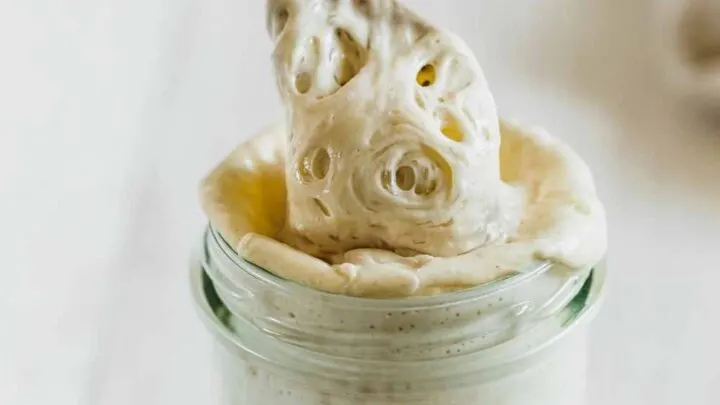
Rehydrating Dried Sourdough Starter Recipe
This shows you how to rehydrate a dried sourdough starter. Its an easy process taking from five to seven days.
Ingredients
- 2 Tablespoon dried sourdough starter (crushed)
- 1 Tablespoon sugar
- 2 1/2 Cups all purpose flour
- 2 Cups water
Instructions
- PREP Notes:
- Sourdough starter is acidic and can react with metals when in long term contact with them. For this reason we recommend you choose a glass or plastic container for the rehydration process.
- Kayti made a video of how she rehydrated her Zourdough Beast starter. This method takes several days but the starter will be active and ready to bake at day six.
Day One:
- In a medium sized glass or plastic mixing bowl combine the 1/2 Cup flour, sugar, 1/2 Cup warm water and the dried starter.

- Mix until smooth.
- cover and set in a warm place.
Day Two:
- mix the rehydrated starter and let it sit covered in a warm place.
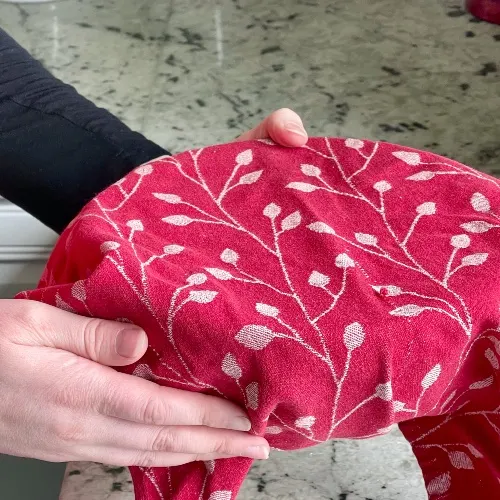
Day Three:
- Add 1/2 Cup flour and 1/2 Cup lukewarm water.
- Stir it and see there is some bubbles starting to form.
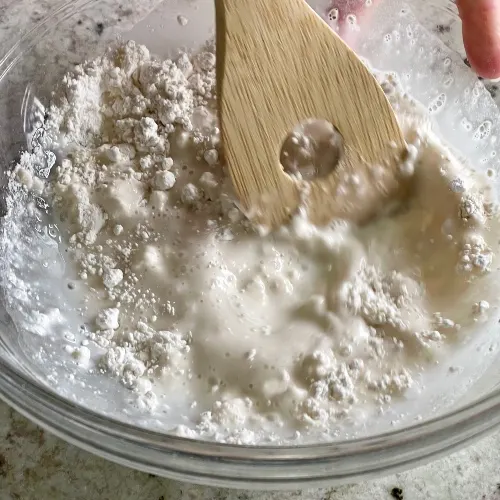
- Cover and set in warm place.
Day Four:
- Add 1/2 cup Flour and 1/2 Cup warm water.
- Stir and notice more bubble action.
- Cover and set aside in warm place.
Day Five:
- Discard HALF of the sourdough in your bowl. This discard is active enough to make sourdough pancakes or you can reserve it for cookies or other discard recipes.
- Feed the remaining sourdough starter with 1 Cup flour and 1/2 cup warm water.
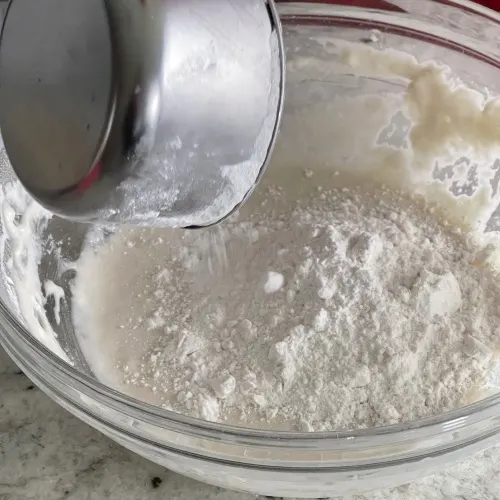
- Stir it together. This will be a thick batter.
- Cover and set aside in a warm place.
Day Six:
- At this point you should have an active starter. Do the float test and if it passes then try your favorite sourdough recipe.
- Store the unused starter in the fridge and feed weekly to keep it active. Read our post on how to properly Feed your starter to keep it well maintained.
Notes
The video below shows Kayti rehydrating the Dried starter we purchased from Zourdough Sourdough on Esty. Highly Recommend!
Nutrition Information
Yield
4Serving Size
1Amount Per Serving Calories 190Total Fat 0gSaturated Fat 0gTrans Fat 0gUnsaturated Fat 0gCholesterol 0mgSodium 5mgCarbohydrates 40gFiber 1gSugar 3gProtein 5g
We purchased Zourdough Sourdough’s Beast starter from Etsy. This one offers a distinctly San Francisco tang. We cannot reproduce this tangy sourdough flavor our mild, local Western Washington wild yeasts. The beast makes a wonderful artisan sourdough bread with a lovely sharply sourdough flavor.
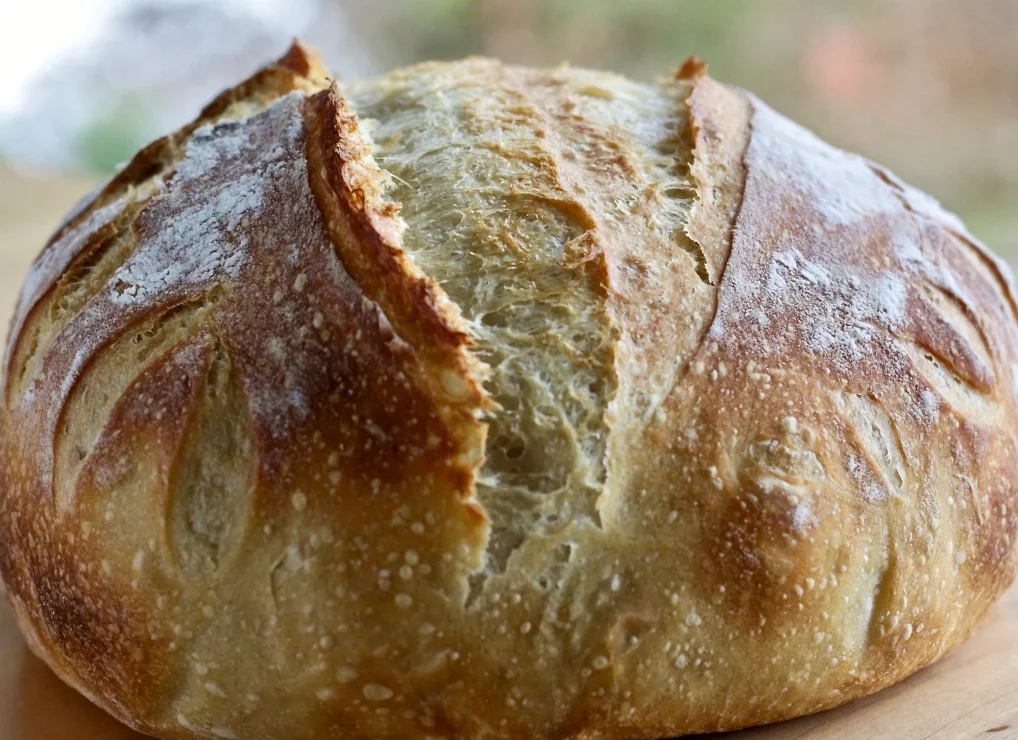
Looking for delicious sourdough bread recipes to make? Here are a few of our favorites. Give em a try and tell us what you think!
- Multi Seed sourdough Bread
- Sourdough Jalapeño Cheese Bread
- Oatmeal bread sourdough loaf
- cranberry walnut bread
- sourdough rosemary garlic bread
- Beginner Artisan Sourdough Bread Recipe
Follow Us:
We enjoy meeting you on our social networks. Follow us on Facebook, Pinterest, Instagram . Tag us with your pictures of our recipes and comment on how it went for you. We would love to see what you do with them.
We often like, comment and share your posts of our recipes on our daily Instagram stories.
Ask questions and rate the recipe in the comments section below. Please share what you did with this recipe. We are always looking for more and better ways to make homemade food. Other cooks love your ideas!
Recent Posts:
